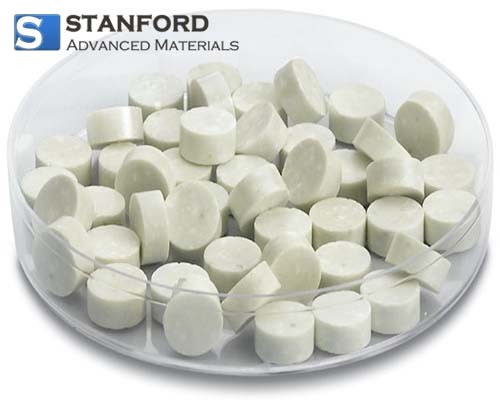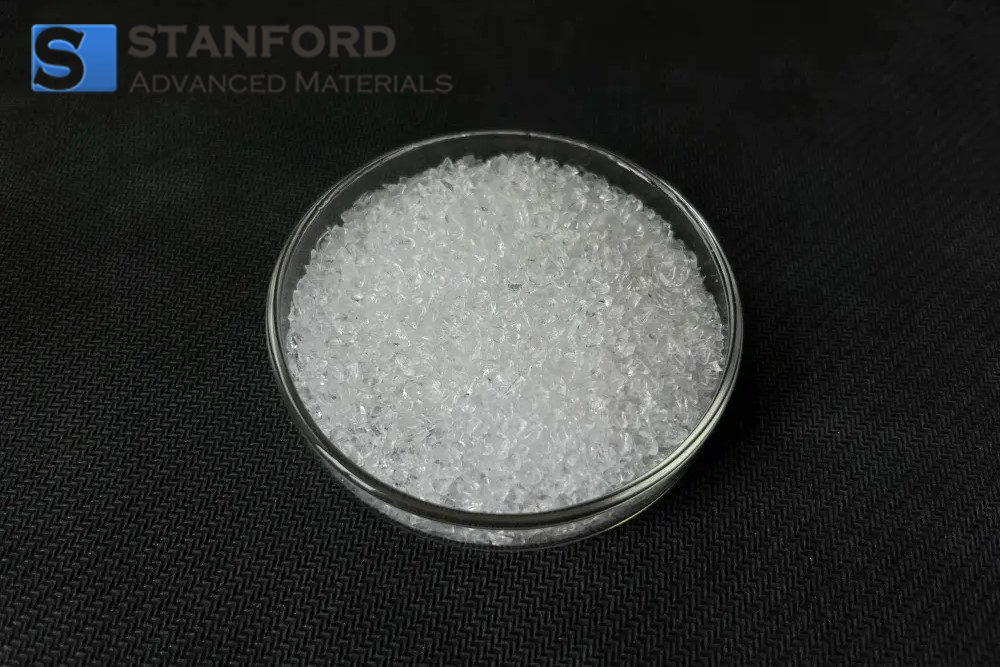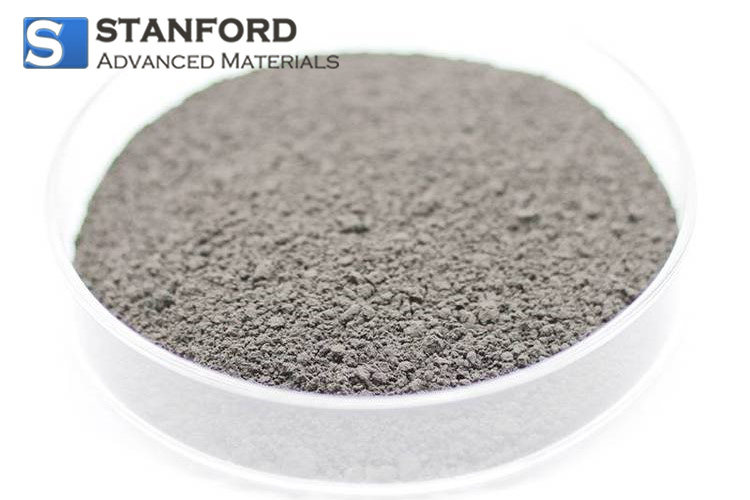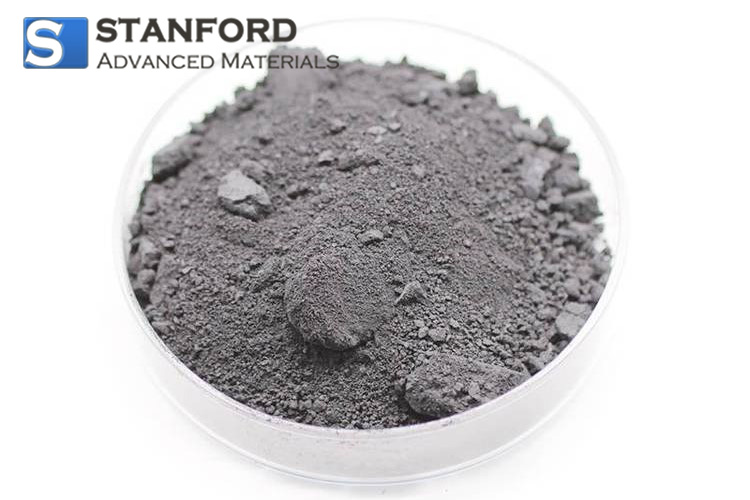SECTION 1. IDENTIFICATION
Product Name: Lead Telluride
CAS #: 1314-91-6
Relevant identified uses of the substance: Scientific research and development
Supplier details:
Stanford Advanced Materials
E-mail: sales@samaterials.com
Tel: (949) 407-8904
Address: 23661 Birtcher Dr., Lake Forest, CA 92630 U.S.A.
SECTION 2. HAZARDS IDENTIFICATION
Classification of the substance or mixture in accordance with 29 CFR 1910 (OSHA HCS)
GHS08 Health hazard
Repr. 1A
H360 May damage fertility or the unborn child.
STOT RE 2 H373 May cause damage to organs through prolonged or repeated exposure.
GHS07
Acute Tox. 4 H302 Harmful if swallowed.
Acute Tox. 4 H332 Harmful if inhaled.
Hazards not otherwise classified
No data available
GHS label elements
GHS label elements, including precautionary statements
Hazard pictograms
GHS07 GHS08
Signal word: Danger
Hazard statementsH302+H332 Harmful if swallowed or if inhaled.
H360
May damage fertility or the unborn child.
H373
May cause damage to organs through prolonged or repeated exposure.
Precautionary statements
P260
Do not breathe dust/fume/gas/mist/vapors/spray.
P261
Avoid breathing dust/fume/gas/mist/vapors/spray.
P281
Use personal protective equipment as required.
P304+P340 IF INHALED: Remove person to fresh air and keep comfortable for breathing.
P405
Store locked up.
P501
Dispose of contents/container in accordance with local/regional/national/international regulations.
WHMIS classification
D2A - Very toxic material causing other toxic effects
Classification system
HMIS ratings (scale 0-4)
(Hazardous Materials Identification System)
Health (acute effects) = 2
Flammability = 0
Physical Hazard = 1
Other hazards
Results of PBT and vPvB assessment
PBT: N/A
vPvB: N/A
SECTION 3. COMPOSITION/INFORMATION ON INGREDIENTS
Substances
CAS No. / Substance Name:
1314-91-6 Lead (II) telluride
Identification number(s):
EC number: 215-247-1
Index number: 082-001-00-6
SECTION 4. FIRST AID MEASURES
Description of first aid measures
If inhaled:
Supply patient with fresh air. If not breathing, provide artificial respiration. Keep patient warm.
Seek immediate medical advice.
In case of skin contact:
Immediately wash with soap and water; rinse thoroughly.
Seek immediate medical advice.
In case of eye contact:
Rinse opened eye for several minutes under running water. Consult a physician.
If swallowed:Seek medical treatment.
Information for doctor
Most important symptoms and effects, both acute and delayed
No data available
Indication of any immediate medical attention and special treatment needed
No data available
SECTION 5. FIREFIGHTING MEASURES
Extinguishing media
Suitable extinguishing agents
Special powder for metal fires. Do not use water.
Special hazards arising from the substance or mixture
If this product is involved in a fire, the following can be released:
Advice for firefighters
Protective equipment:
Wear self-contained respirator.
Wear fully protective impervious suit.
SECTION 6. ACCIDENTAL RELEASE MEASURES
Personal precautions, protective equipment and emergency procedures
Use personal protective equipment. Keep unprotected persons away.
Ensure adequate ventilation
Environmental precautions:
Do not allow material to be released to the environment without official permits.
Methods and materials for containment and cleanup:
Dispose of contaminated material as waste according to section 13.
Ensure adequate ventilation.
Prevention of secondary hazards:
No special measures required.
Reference to other sections
See Section 7 for information on safe handling
See Section 8 for information on personal protection equipment.
See Section 13 for disposal information.
SECTION 7. HANDLING AND STORAGE
Handling
Precautions for safe handling
Keep container tightly sealed.
Store in cool, dry place in tightly closed containers.
Ensure good ventilation at the workplace.
Open and handle container with care.
Information about protection against explosions and fires:
No data available
Conditions for safe storage, including any incompatibilities
Requirements to be met by storerooms and receptacles:
No special requirements.
Information about storage in one common storage facility:Not required.
Further information about storage conditions:
Keep container tightly sealed.
Store in cool, dry conditions in well-sealed containers.
Specific end use(s)
No data available
SECTION 8. EXPOSURE CONTROLS/PERSONAL PROTECTION
Additional information about design of technical systems:
Properly operating chemical fume hood designed for hazardous chemicals and having an average
face velocity of at least 100 feet per minute.
Additional information: No data
Exposure controls
Personal protective equipment
Follow typical protective and hygienic practices for handling chemicals.
Keep away from foodstuffs, beverages and feed.
Remove all soiled and contaminated clothing immediately.
Wash hands before breaks and at the end of work.
Store protective clothing separately.
Maintain an ergonomically appropriate working environment.
Breathing equipment:
Use suitable respirator when high concentrations are present.
Refer to 29CFR1910.1025 for regulations on respiratory protection required during exposure to lead
and lead compounds.
Protection of hands:
Impervious gloves
Inspect gloves prior to use.
The selection of suitable gloves not only depends on the material, but also on quality. Quality will vary
from manufacturer to manufacturer.
Eye protection: Safety glasses
Body protection: Protective work clothing.
SECTION 9. PHYSICAL AND CHEMICAL PROPERTIES
Information on basic physical and chemical properties
Appearance:
Form: Chunks
Color: Grey
Odor: Product specific
Odor threshold: No data available.
pH: N/A
Melting point/Melting range: 917 °C (1683 °F)
Boiling point/Boiling range: No data available
Sublimation temperature / start: No data available
Flash point: N/A
Flammability (solid, gas): No data available.
Ignition temperature: No data available
Decomposition temperature: No data available
Autoignition: No data available.
Danger of explosion: Product does not present an explosion hazard.Explosion limits:
Lower: No data available
Upper: No data available
Vapor pressure: N/A
Density at 20 °C (68 °F): 8.16 g/cm
3
(68.095 lbs/gal)
Relative density: No data available.
Vapor density: N/A
Evaporation rate: N/A
Solubility in Water (H
2
O): Insoluble
Partition coefficient (n-octanol/water): No data available.
Viscosity:
Dynamic: N/A
Kinematic: N/A
Other information
No data available
SECTION 10. STABILITY AND REACTIVITY
Reactivity
No data available
Chemical stability
Stable under recommended storage conditions.
Thermal decomposition / conditions to be avoided:
Decomposition will not occur if used and stored according to specifications.
Possibility of hazardous reactions
No dangerous reactions known
Conditions to avoid
No data available
Incompatible materials:
No data available
Hazardous decomposition products:
Poisonous gases/vapors
Toxic metal compounds
SECTION 11. TOXICOLOGICAL INFORMATION
Information on toxicological effects
Acute toxicity:
Harmful if inhaled.
Harmful if swallowed.
LD/LC50 values that are relevant for classification: No data
Skin irritation or corrosion: Irritant to skin and mucous membranes.
Eye irritation or corrosion: Irritating effect.
Sensitization: No sensitizing effects known.
Germ cell mutagenicity: No effects known.
Carcinogenicity:
EPA-B2: Probable human carcinogen, sufficient evidence from animal studies; inadequate evidence or
no data from epidemiologic studies.
IARC-2B: Possibly carcinogenic to humans: limited evidence in humans in the absence of sufficient
evidence in experimental animals.
NTP-R: Reasonably anticipated to be a carcinogen: limited evidence from studies in humans orsufficient evidence from studies in experimental animals.
ACGIH A3: Animal carcinogen: Agent is carcinogenic in experimental animals at a relatively high dose,
by route(s) of administration, at site(s), of histologic type(s), or by mechanism(s) not considered
relevant to worker exposure. Available epidemologic studies do not confirm an increased risk of
cancer in exposed humans. Available evidence suggests that the agent is not likely to cause cancer in
humans except under uncommon or unlikely routes or levels of exposure.
Reproductive toxicity: May damage fertility or the unborn child.
Specific target organ system toxicity - repeated exposure: May cause damage to organs through
prolonged or repeated exposure.
Specific target organ system toxicity - single exposure: No effects known.
Aspiration hazard: No effects known.
Subacute to chronic toxicity:
Lead and lead compounds may cause abdominal pain, diarrhea, loss of appetite, metallic taste,
nausea, vomiting, lassitude, insomnia, muscle weakness, joint and muscle pain, irritability, headache
and dizziness. Red blood cells may be damaged resulting in anemia. Gastritis and injury to the
kidneys, liver, male gonads, and central nervous system may also occur.
Tellurium is converted in the body to dimethyl telluride which imparts a garlic-like odor to the breath
and sweat. Heavy exposure may result in headache, drowsiness, metallic taste, loss of appetite,
nausea, tremors, convulsions, and respiratory arrest.
Subacute to chronic toxicity: No effects known.
Additional toxicological information:
To the best of our knowledge the acute and chronic toxicity of this substance is not fully known.
SECTION 12. ECOLOGICAL INFORMATION
Toxicity
Aquatic toxicity:
No data available
Persistence and degradability
No data available
Bioaccumulative potential
No data available
Mobility in soil
No data available
Ecotoxical effects:
Remark:
Very toxic for aquatic organisms
Additional ecological information:
Do not allow material to be released to the environment without official permits.
Do not allow product to reach groundwater, water courses, or sewage systems, even in small
quantities.
Danger to drinking water if even extremely small quantities leak into the ground.
Also poisonous for fish and plankton in water bodies.
May cause long lasting harmful effects to aquatic life.
Avoid transfer into the environment.
Very toxic for aquatic organisms
Results of PBT and vPvB assessment
PBT: N/A
vPvB: N/A
Other adverse effects
No data available
SECTION 13. DISPOSAL CONSIDERATIONS
Waste treatment methods
Recommendation
Consult official regulations to ensure proper disposal.
Uncleaned packagings:
Recommendation:
Disposal must be made according to official regulations.
SECTION 14. TRANSPORT INFORMATION
UN-Number
DOT, IMDG, IATA
UN3077
UN proper shipping name
DOT
Environmentally hazardous substances, solid, n.o.s. (Lead (II) telluride)
IMDG, IATA
ENVIRONMENTALLY HAZARDOUS SUBSTANCE, SOLID, N.O.S. (Lead (II) telluride)
Transport hazard class(es)
DOT, IMDG
Class
9 Miscellaneous dangerous substances and articles.
Label
9
Class
9 (M7) Miscellaneous dangerous substances and articles
Label
9
IATA
Class
9 Miscellaneous dangerous substances and articles.
Label
9
Packing group
DOT, IMDG, IATA
III
Environmental hazards:
Special marking (ADR):
Symbol (fish and tree)
Special marking (IATA):
Symbol (fish and tree)
Special precautions for user
Warning: Miscellaneous dangerous substances and articles
Transport in bulk according to Annex II of MARPOL73/78 and the IBC Code
N/A
Transport/Additional information:
DOT
Marine Pollutant (DOT):
No
UN "Model Regulation":UN3077, Environmentally hazardous substances, solid, n.o.s. (Lead (II) telluride), 9, III
SECTION 15. REGULATORY INFORMATION
Safety, health and environmental regulations/legislation specific for the substance or mixture
GHS GHS label elements, including precautionary statements
Hazard pictograms
GHS07
GHS08
Signal word: Danger
Hazard statements
H302+H332 Harmful if swallowed or if inhaled.
H360
May damage fertility or the unborn child.
H373
May cause damage to organs through prolonged or repeated exposure.
Precautionary statements
P260
Do not breathe dust/fume/gas/mist/vapors/spray.
P261
Avoid breathing dust/fume/gas/mist/vapors/spray.
P281
Use personal protective equipment as required.
P304+P340 IF INHALED: Remove person to fresh air and keep comfortable for breathing.
P405
Store locked up.
P501
Dispose of contents/container in accordance with local/regional/national/international regulations.
National regulations
All components of this product are listed in the U.S. Environmental Protection Agency Toxic
Substances Control Act Chemical substance Inventory.
All components of this product are listed on the Canadian Domestic Substances List (DSL).
SARA Section 313 (specific toxic chemical listings)
1314-91-6 Lead (II) telluride
California Proposition 65
Prop 65 - Chemicals known to cause cancer
1314-91-6 Lead (II) telluride
Prop 65 - Developmental toxicity
Substance is not listed.
Prop 65 - Developmental toxicity, female
Substance is not listed.
Prop 65 - Developmental toxicity, male
Substance is not listed.
Information about limitation of use:
For use only by technically qualified individuals.
This product contains lead and is subject to the reporting requirements of section 313 of the
Emergency Planning and Community Right to Know Act of 1986 and
40CFR372.
Other regulations, limitations and prohibitive regulations
Refer to 29CFR1910.1025 for regulations concerning lead and lead compounds.
Substance of Very High Concern (SVHC) according to the REACH Regulations (EC) No. 1907/2006.
Substance is not listed.
The conditions of restrictions according to Article 67 and Annex XVII of the Regulation (EC) No1907/2006 (REACH) for the manufacturing, placing on the market and use must be observed.
Substance is not listed.
Annex XIV of the REACH Regulations (requiring Authorisation for use)
Substance is not listed.
Chemical safety assessment:
A Chemical Safety Assessment has not been carried out.
SECTION 16. OTHER INFORMATION
Safety Data Sheet according to Regulation (EC) No. 1907/2006 (REACH). The above information is
believed to be correct but does not purport to be all inclusive and shall be used only as a guide. The
information in this document is based on the present state of our knowledge and is applicable to the
product with regard to appropriate safety precautions. It does not represent any guarantee of the
properties of the product.
.jpg)









